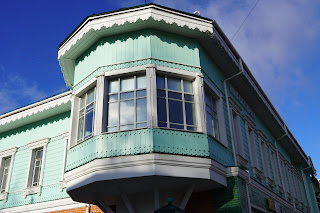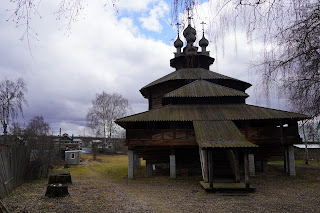When I
first put Kostroma on my list of places to go it was because I saw a
pretty picture on social media. I was thrilled when I realized it was
also listed in my guidebook.
Kostroma
is one of the so-called Golden Ring towns around Moscow. The 2010
census said there were almost 270,000 residents in a city a little
over 330 kilometers northeast of Moscow. Fun fact: Kostroma is the
name of the East Slavic goddess of fertility. Why this name was chosen for a town name, I don't know.
The
first official mention of Kostroma in written history was in 1213,
but there are a few arguments that the city was older, even arguments
saying several centuries older. There is the thought that Kostroma
was founded in 1152, and there are thoughts that the history of the
town could go as far back as 400-600 CE.
Like
pretty much every town in Russia, Kostroma was taken by the Mongols
when they were creating the largest empire the world has ever known.
When Mongol warriors moved on, they left locals (Russians) in charge,
as they did in most places they conquered during that time.
Kostroma
finally received official town status in 1719, despite being around
for several hundred years at that point. In 1773 a massive fire
destroyed much of the city. The rebuild included streets radiating
from a single point near the banks of the Kostroma River. Legend has
it that Catherine the Great dropped her fan on a map of the city, and
told architects in charge of rebuilding to follow her lead.
When I
booked my train tickets to Kostroma I thought it was a small town, so
I booked tickets for two night trains in a row. I also booked the
dates by accident.
When I made the booking, I thought it was in
February, but I actually clicked on the dates in March, whoops!
Thankfully the dates in March were still on a weekend. Also
thankfully, when I double checked the train departure time in
February I did so before arriving at the train station, so I noticed
the mistaken dates before getting to the train station and getting
frustrated with myself.
My
train arrived on time in Kostroma, as expected. Since it was still
dark when I arrived, I stayed in the station for a couple hours,
sitting on a chair near a plug. The station was not exciting, but
they can't all be.
The
train station in Kostroma is nowhere near the city center, but I had
all day, so not long after daylight I started walking. Not too far
from the train station I saw a mosque, which is not something you see
a lot of in Russia. It wasn't particularly good looking, but the
recent weather had left lots of puddles, so the reflection in water
was quite nice.
I kept
walking along the main street, enjoying the random buildings along
the way. Since it was still before 0900, there weren't many other
people around.
Eventually I got to the place where I took my
favourite photo during this trip.
The
Church of the Saviour in the Ranks is a typical Orthodox church,
originally built for merchants. What made it special for me is the
location, on one end of an arcaded central market. As a puddle had
helped me make a nice photo of a mosque an hour earlier, another
puddle helped me make a photo of this market and church. I love
reflection photos.
I
wanted to see the inside of the church, and take photos, but there
was a service taking place when I opened the door so I only stayed
inside for a few minutes, and took no photos.
This
church and market were close to the main square (the 'center of the
fan, if you will,) from which some of the streets of the city
radiate. Named after the town hero, Susanin Square is quite pretty
from a couple perspectives.
Standing
in the middle of the square (which is a landscaped area in warmer
months,) I had the perfect viewpoint of the former fire station. It
has a gorgeous fire tower, (used to watch out for fires back in the
day,) but is now used as a history/art museum. Really photogenic, if
you have the patience to wait for a moment when no one is walking in
front of the whole thing.
Since
I love to find Lenin statues, that was my next goal. I'd found two of
them listed on a map, so I headed up Lenin street toward one of them.
The walk was rather long, and not through a pretty part of town, to
say the least. I finally got to the statue, it was less than
impressive. He was pretty small, compared to other statues, and in a
very small park/square off an intersection.
If I
hadn't been looking for this Lenin statue, I never would've noticed
this one, (partly because it is in such a random part of the city,)
mostly because it would've been super easy to walk right past the
area. Anywho, I took my normal photo with the statue, then found the
closest bus stop.
Even though I love walking, I didn't want to spend
another hour and some getting to my next sight.
After
hopping off the marshrutka, I stumbled upon two churches on my way to
another church. The first church wasn't amazing, but I did like the
cemetery that surrounded the church. The second church was wooden,
and surrounded by a fence, and the gate was locked. I wish I had been
able to enter that one.
My
next sight is probably the most visited sight in Kostroma.
Ipatiev
Monastery is like the city in that it has multiple founding dates.
The Wikipedia article says the monastery was founded in 1330 by
Prince Chet, an Orthodox convert, a Tatar. The article goes on to say
that some historians think it was actually founded by Yaroslavich, in
1275, but then declined as the whole region declined. Looking at the
history this way, Prince Chet only revived the place. I don't really
care which is the correct founding date, as it doesn't impact the
experience of a visitor.
The
Romanov family was a big fan of this monastery, several of them
visited or lived in the monastery. The house in which Tsar Mikhail
Romanov lived in has been preserved, near one of the walls of the
area. It wasn't difficult to find the entry gate, as there is a
lovely mural painted above the gate, with a cross on top of the whole
thing.
There
is an entrance fee to visit the monastery, there is also a photo fee.
Argh. Put the fees together, it's not terribly cheap. Women have to
wear headscarves and skirts, both are available to borrow, and they
do make sure you're wearing them.
I'm not sure wearing a wraparound
skirt over a pair of pants and a winter coat is particularly
respectful (because my opinion is that it looks ridiculous,) but it
isn't my choice.
I
think there are typically two churches to visit in this monastery,
but one of them was closed for renovation. Argh. The main church was
plain white on the outside, which didn't prepare me for the riot of
colour inside. The interior wasn't big, but it was tall, and every
square centimeter was painted. I might've gotten whiplash from the
way I was trying to look in every direction at the same time.
Even
the hallway outside the church was fully covered with frescoes.
Neither the inside nor the hallway were bright, but there was just so
much colour that I loved it all. There was a gold iconostasis up
front, but it didn't stand out because of all the colour everywhere.
As the
moastery is on the western bank of the Kostroma River, not close to
the city center, I chose to walk back toward the city center. The
bridge I crossed probably has a great view of the monastery on the
river, but that side of the was being redone, so I didn't get that
view. Argh.
On my
way back into the city center I passed a big rock monument. Since
rocks are generally quite boring, I read the accompanying sign, which
said that this was where the city had been founded.
I
walked through the arcaded market this time, but on the other side
from what I'd seen previously. Vendors were selling the same things
I've seen in every Russian market: produce, dairy, second hand goods,
etc...
I kept
going, and eventually got to the central park. In one area of the
park was a huge Lenin statue. Not only was the statue quite big, it
was on a big and fancy pedestal. Definitely one of the most grand
Lenin statues I've seen.
I
attempted to go to the teapot museum next. I love tea, how awesome
did this museum sound? I was gutted when I got to the entrance gate
and discovered you have to call ahead of time to arrange a tour, and
you have to have a group of at least six people. Needless to say, its
not likely I'll ever get to see this museum, darnit.
I did
get to see the cheese museum, which also requires a tour. The tour is
in Russian, so I didn't understand much, but it was fun to look
around in each room and try to figure out what the guide was saying.
Russian cheese isn't all that exciting, but it was nice to try to
learn a bit about the history and industry in Russia.
After
that I had one more museum to visit, this one dedicated to the
Romanovs. Go figure, when I got to the ticket desk I had to try to
sort out a bunch of different ticket options. They had an English
menu as well, but the options didn't seem to be the same as the
Russian menu, which made it even worse to sort it out. I finally
chose two areas to visit, after which they tried to get me to buy a
three area ticket. Argh. I had to repeat several times that I just
wanted these two areas.
Then when visiting the first room I
discovered it had a separate photo fee, but the second area didn't.
The
museum exhibits were nice, but I was so annoyed by the ticket process
that I didn't enjoy it as much as I should've. I did appreciate the
grand staircase with pieces of art displayed on the walls along the
stairs. Very nice.
After
leaving this museum I decided I had seen enough for the day. It
snowed briefly while I walked to a cafe, thankfully not for long. I
killed a few hours in the cafe, then walked back to the train station
where I killed a few more hours before boarding my train and
departing for Moscow.
I'd
like to go back to Kostroma, to see a couple more museums and views,
and experience the town in warmer weather :)

















No comments:
Post a Comment